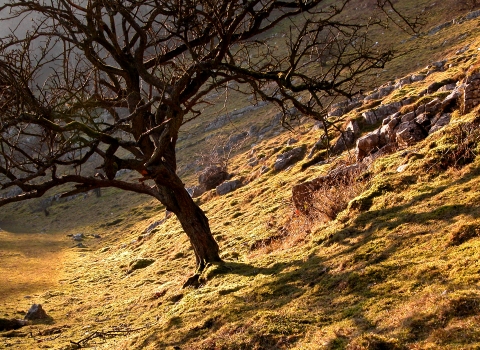Common Spotted Orchid - Cath Shellswell
Know before you go
Dogs
Visit the 'Dog walking on reserves' page in the Contact section for more information.
When to visit
Opening times
Open at all timesBest time to visit
April to JulyAbout the reserve
This Mendip reserve contains important habitats both above and under ground; above you will find neutral to acid species-rich grassland and under a large swallet complex cave system exists.
In spring and summer a rich variety of plants grow in this distinctive landscape, such as Hairy Rock-cress, Alpine Penny-cress and the nationally scarce Dwarf Mouse-Ear. A speciality here is the lead tolerant Spring Sandwort which occurs on the old spoil heaps of mining waste. Wet, neutral grassland is found in the northern field, typified by plants such as Betony, Meadow Thistle, Devil’s-bit Scabious and Common Lousewort.
The Tyning’s Farm stream which flows through the reserve encourages water-loving stream side plants such as Lesser Spearwort, Meadow-Rue and Lesser Water-Plantain. It also provides the humid conditions suitable for many ferns including Narrow Buckler, Hard Shield, and Brittle Bladder-fern. Tussocks of Purple Moor-grass, Tufted Hair-grass and Soft Rush mark the two streams even when you can’t see them as they run underground. In drier areas you can find plants such as Common Spotted Orchid, Adder’s-tongue Fern and Pignut.
This wonderful variety of plants and flowers attracts many butterflies such as Green Hairstreak, Small Copper, Marbled White and Meadow Brown. Also look out for day flying Chimney Sweeper Moths during early Summer. This sooty black moth can be seen in good numbers, normally in close association with its caterpillars food plant Pignut. Redstart, Stonechat and Yellowhammers are regular summer visitors to the reserve and Ravens are often seen as they nest locally. Snipe visit wet ground in the reserve to feed in winter although which such excellent camouflage you’ll be lucky to spot one.
There are two large Badger setts on the reserve making this a great spot to see these shy animals at dusk. Lesser Horseshoe Bats roost in the underground caves. These bats get their name from the distinctive horseshoe-shaped nose and they are one of the world's smallest bats, weighing only five to nine grams.
Reserve conservation management - The reserve is managed primarily by grazing with Exmoor Ponies or sheep, which keeps the vegetation low to allow flowering plants to flourish. Encroaching scrub and bracken is cleared to restore the grassland, although some smaller patches are retained to provide cover for insects and birds.
History and Archaeology - Lead has been mined at GB Gruffy in the past, leaving a distinctive pitted surface. This disturbed land is known locally as ‘gruffy’ or ‘groovy’ ground. Although beyond the reach of all but bats and very experienced cavers there is a fascinating world beneath your feet at GB Gruffy with two of Mendips most impressive cave systems - GB Cave and Charterhouse Cave. GB Cave is around 1.93km long and 134 metres deep, its main feature being the gorge, a tunnel large enough to take several double decker buses. This descends steeply to Main Chamber, the largest known underground cavity in Mendip. Charterhouse Cave is 4,340 metres long, currently the deepest known cave on Mendip. The cave was first entered on 19 November 1939, after ten months of digging, by the University of Bristol Spelæological Society, and was named in recognition of the two members, F. J. Goddard and C. C. Barker, who had done most of the work involved in its discovery. The entrance to the cave is kept locked, and access is controlled by the Charterhouse Caving Company; Do not enter without permission.



